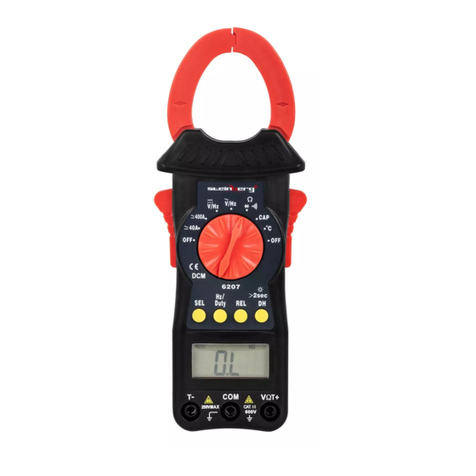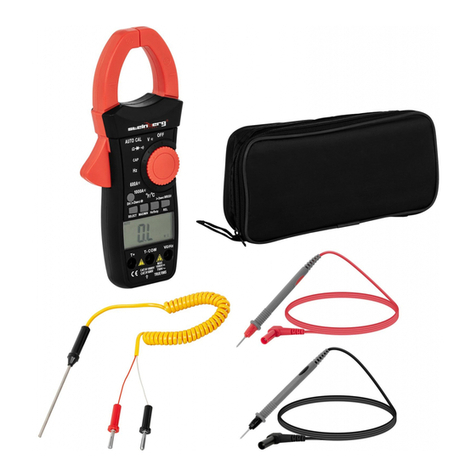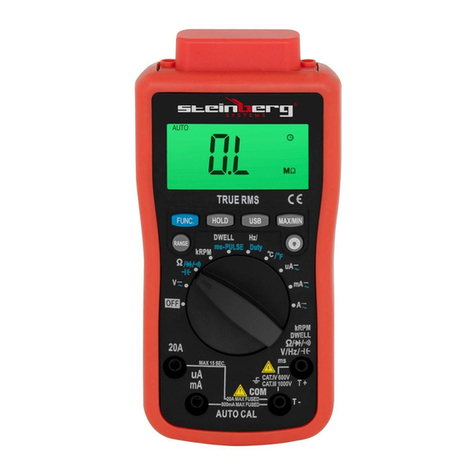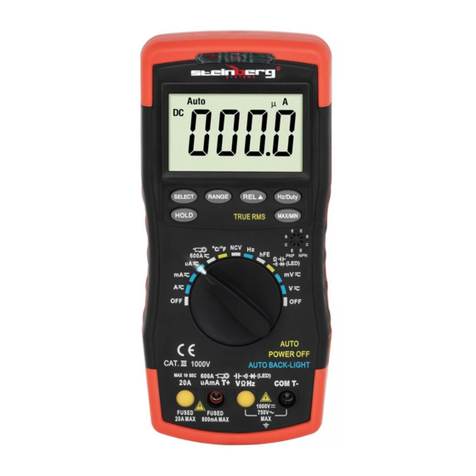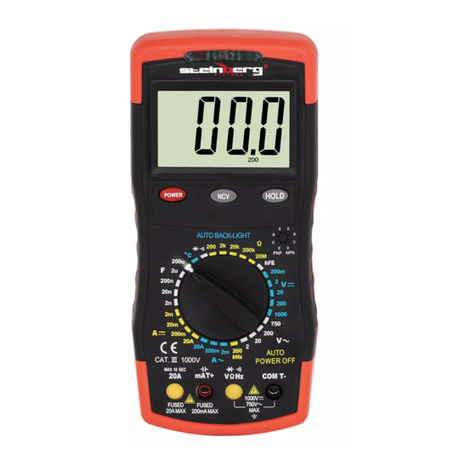
12 13
09.07.2019
Produkt podlegający recyklingowi.
UWAGA! lub OSTRZEŻENIE! lub PAMIĘTAJ!
opisująca daną sytuację (ogólny znak
ostrzegawczy).
Do użytku tylko wewnątrz pomieszczeń.
Opis parametru Wartość parametru
Nazwa produktu Multimetr
Model SBS-DM-1000
Typ baterii 9V
Moc znamionowa [W] 3
Klasa ochrony IP IP20
Ochrona
przeciwprzepięciowa
CATIII 1000V
Zakres pomiaru napięcia
prądu stałego/
przemiennego
200mV~1000V/ 2V~700V
Zakres pomiaru
natężenia prądu stałego/
przemiennego
2mA~20A/ 2mA~20A
Zakres pomiaru oporności/
pojemności elektrycznej
200Ω~20MΩ/
2nF~200µF
Zakres pomiaru
temperatury/
częstotliwości
-20~1000~/~200kHz
Temperatura pracy
gwarantująca największą
dokładność pomiaru [°C]
23±5
Temperatura pracy/
Wilgotność względna
pracy [°C, %RH]
0~40°C/≤75%
Temperatura składowania/
Wilgotność względna
składowania [°C, °F/%RH]
-20~60°C/≤80%
Wymiary [mm] 195x89x40
Ciężar [kg] 0,32
DANE TECHNICZNE
Termin „urządzenie” lub „produkt” w ostrzeżeniach
i w opisie instrukcji odnosi się do <Multimetr>. Nie należy
używać urządzenia w pomieszczeniach o bardzo dużej
wilgotności / w bezpośrednim pobliżu zbiorników z wodą!
Nie wolno dopuszczać do zamoczenia urządzenia.
Ryzyko porażenia prądem! Nie wolno zasłaniać otworów
wentylacyjnych urządzenia!
2.1. BEZPIECZEŃSTWO ELEKTRYCZNE
a) Podczas pomiaru napięcia upewnić się, że pokrętło
jest ustawione na odpowiedni zakres.
b) Zachować szczególną ostrożność podczas pomiaru
napięcia powyżej 50V.
c) W miarę możliwości unikać podłączania urządzenia
do obwodów będących „pod napięciem”.
d) Przed wykonaniem pomiarów: rezystancji, testu
diod lub ciągłości, testu pojemności lub testu
temperatury, upewnić się, że testowany obwód nie
jest pod napięciem.
e) Przed wykonaniem pomiarów upewnić się, że
wybrano poprawną funkcję i zakres pomiaru.
f) Należy zachować szczególną ostrożność w przypadku
wystąpienia przerwy w obwodzie podczas korzystania
z urządzenia w układzie z przekładnikiem prądowym
podłączonym do zacisków.
g) Przed każdym użyciem należy upewnić się, że
przewody i sondy pomiarowe są w dobrym stanie
technicznym np. bez uszkodzenia izolacji.
h) Przed demontażem pokrywy baterii zawsze należy
wyłączyć urządzenie oraz odłączyć przewody i sondy
pomiarowe od urządzenia.
i) Podczas dokonywania pomiaru przewody
pomiarowe należy trzymać za izolowane części.
j) Podczas wykonywania pomiarów należy stosować się
do ogólnych zasad i wiedzy elektrotechnicznej.
INSTRUKCJA OBSŁUGI
1. OGÓLNY OPIS
Instrukcja przeznaczona jest do pomocy w bezpiecznym
i niezawodnym użytkowaniu. Produkt jest zaprojektowany
i wykonany ściśle według wskazań technicznych przy
użyciu najnowszych technologii i komponentów oraz przy
zachowaniu najwyższych standardów jakości.
PRZED PRZYSTĄPIENIEM DO PRACY NALEŻY
DOKŁADNIE PRZECZYTAĆ I ZROZUMIEĆ NINIEJSZĄ
INSTRUKCJĘ.
Dla zapewnienia długiej i niezawodnej pracy urządzenia
należy dbać o jego prawidłową obsługę oraz konserwację
zgodnie ze wskazówkami zawartymi w tej instrukcji. Dane
techniczne i specykacje zawarte w tej instrukcji obsługi są
aktualne. Producent zastrzega sobie prawo dokonywania
zmian związanych z podwyższeniem jakości.
2. BEZPIECZEŃSTWO UŻYTKOWANIA
UWAGA! Przeczytaj wszystkie ostrzeżenia
dotyczące bezpieczeństwa oraz wszystkie instrukcje.
Niezastosowanie się do ostrzeżeń i instrukcji może
spowodować porażenie prądem, pożar i/lub ciężkie
obrażenia ciała lub śmierć.
Instrukcją oryginalną jest niemiecka wersja instrukcji.
Pozostałe wersje językowe są tłumaczeniami z języka
niemieckiego.
UWAGA! Ilustracje w niniejszej instrukcji obsługi
mają charakter poglądowy i w niektórych szczegółach
mogą różnić się od rzeczywistego wyglądu produktu.
PL
OBJAŚNIENIE SYMBOLI
2.2. BEZPIECZEŃSTWO W MIEJSCU PRACY
a) Nie używać urządzenia w stree zagrożenia
wybuchem, na przykład w obecności łatwopalnych
cieczy, gazów lub pyłów.
b) W razie stwierdzenia uszkodzenia lub
nieprawidłowości w pracy urządzenia należy je
bezzwłocznie wyłączyć i zgłosić to do osoby
uprawnionej.
c) W razie wątpliwości czy urządzenia działa poprawnie,
należy skontaktować się z serwisem producenta.
Produkt spełnia wymagania odpowiednich
norm bezpieczeństwa.
Przed użyciem należy zapoznać się z instrukcją.
UWAGA! Pomimo iż urządzenie zostało
zaprojektowane tak aby było bezpieczne, posiadało
odpowiednie środki ochrony oraz pomimo użycia
dodatkowych elementów zabezpieczających
użytkownika, nadal istnieje niewielkie ryzyko
wypadku lub odniesienia obrażeń w trakcie pracy
z urządzeniem. Zaleca się zachowanie ostrożności
i rozsądku podczas jego użytkowania.
3. ZASADY UŻYTKOWANIA
Urządzenie jest przeznaczone do wykonywania pomiarów
odległości, powierzchni oraz kubatury.
Odpowiedzialność za wszelkie szkody powstałe
w wyniku użytkowania niezgodnego z przeznaczeniem
ponosi użytkownik.
3.1. OPIS URZĄDZENIA
3.2. PRZYGOTOWANIE DO PRACY
Temperatura otoczenia nie może przekraczać 40°C
a wilgotność względna nie powinna przekraczać 80%.
Należy pamiętać o tym, by zasilanie urządzenia energią
odpowiadało danym podanym na tabliczce znamionowej!
UWAGA! Nie wolno przekraczać wartości granicznych
ochrony przed przeciążeniem.
Szczegółowe parametry (elektryczne) pomiarów:
UWAGA! Rysunki produktu znajdują się na końcu
instrukcji na stronie 37.
PL
Zapis dokładności: ± % z odczytu + ilość ostatnich
cyfr (przy temperaturze: 23(±5)°C, oraz wilgotności
≤ 75% RH).
OPIS PANELU STEROWANIA
1. Wyświetlacz LCD.
2. Przycisk On/Off
3. Przycisk HOLD: Blokowanie/ odblokowywanie
wyświetlanej wartości.
4. Włączanie/wyłączanie podświetlenia ekranu i diody
aktualnie wybranej funkcji
5. Diody informujące o aktualnie aktywnej funkcji
6. Gniazdo wejściowe: hFE
7. Pokrętło: wybór funkcji i zakresu pomiaru
8. Mechaniczna blokada gniazd – zabezpieczenie przed
niewłaściwym użyciem
9. Gniazdo wejściowe:
a) 20A
b) mA
c) VΩHz , pojemność „+”, temperatura „+”
d) COM, pojemność „-„, temperatura „-„
d) Naprawy urządzenia może wykonać wyłącznie
serwis producenta. Nie wolno dokonywać napraw
samodzielnie!
e) W przypadku zaprószenia ognia lub pożaru, do
gaszenia urządzenia pod napięciem należy używać
wyłącznie gaśnic proszkowych lub śniegowych
(CO2).
f) Należy regularnie sprawdzać stan naklejek
z informacjami dotyczącymi bezpieczeństwa.
W przypadku gdy, naklejki są nieczytelne należy je
wymienić.
g) Zachować instrukcję użytkowania w celu jej
późniejszego użycia. W razie, gdyby urządzenie miało
zostać przekazane osobom trzecim, to wraz z nim
należy przekazać również instrukcję użytkowania.
h) Elementy opakowania oraz drobne elementy
montażowe należy przechowywać w miejscu
niedostępnym dla dzieci.
i) W trakcie użytkowania tego urządzenia wraz
z innymi urządzeniami należy zastosować się również
do pozostałych instrukcji użytkowania.
2.3. BEZPIECZEŃSTWO OSOBISTE
a) Niedozwolone jest obsługiwanie urządzenia
w stanie zmęczenia, choroby, pod wpływem
alkoholu, narkotyków lub leków, które ograniczają
w istotnym stopniu zdolności obsługi urządzenia.
b) Urządzenie nie jest przeznaczone do tego, by
było użytkowane przez osoby (w tym dzieci)
o ograniczonych funkcjach psychicznych,
sensorycznych i umysłowych lub nieposiadające
odpowiedniego doświadczenia i/lub wiedzy, chyba
że są one nadzorowane przez osobę odpowiedzialną
za ich bezpieczeństwo lub otrzymały od niej
wskazówki dotyczące tego, jak należy obsługiwać
urządzenie.
c) Podczas pracy z urządzeniem należy zachować
zdrowy rozsądek i zachować czujność. Chwilowa
utrata koncentracji podczas używania urządzenia
może prowadzić do poważnych obrażeń.
d) Aby zapobiec przypadkowemu włączeniu urządzenia,
upewnij się, że przełącznik jest w pozycji OFF przed
podłączeniem do źródła zasilania.
e) Urządzenie nie jest zabawką. Dzieci powinny być
pilnowane, aby nie bawiły się urządzeniem.
2.4. BEZPIECZNE STOSOWANIE URZĄDZENIA
a) Nie należy używać urządzenia, jeśli przełącznik ON/
OFF nie działa sprawnie (nie załącza i nie wyłącza
się). Urządzenia, które nie mogą być kontrolowane
za pomocą przełącznika są niebezpieczne, nie mogą
pracować i muszą zostać naprawione.
b) Nieużywane urządzenia należy przechowywać
w miejscu niedostępnym dla dzieci oraz osób
nieznających urządzenia lub tej instrukcji
obsługi. Urządzenia są niebezpieczne w rękach
niedoświadczonych użytkowników.
c) Utrzymywać urządzenie w dobrym stanie
technicznym.
d) Urządzenie należy chronić przed dziećmi.
e) Naprawa oraz konserwacja urządzeń powinna być
wykonywana przez wykwalikowane osoby przy
użyciu wyłącznie oryginalnych części zamiennych.
Zapewni to bezpieczeństwo użytkowania.
f) Aby zapewnić zaprojektowaną integralność
operacyjną urządzenia, nie należy usuwać
zainstalowanych fabrycznie osłon lub odkręcać śrub.
g) Zabrania się przesuwania, przestawiania i obracania
urządzenia będącego w trakcie pracy.
h) Nie należy pozostawiać włączonego urządzenia bez
nadzoru.
i) Należy regularnie czyścić urządzenie, aby nie
dopuścić do trwałego osadzenia się zanieczyszczeń.
j) Urządzenie nie jest zabawką. Czyszczenie
i konserwacja nie mogą być wykonywane przez
dzieci bez nadzoru osoby dorosłej.
k) Nigdy nie mierzyć wartości napięcia, gdy przewody
pomiarowe są podłączone do gniazd pomiarowych
wartości natężenia prądu.
l) Zachować ostrożność podczas pracy przy napięciu
powyżej DC60V lub AC42V.
m) Podczas wykonywania pomiaru trzymać przewody
pomiarowe lub sondy za izolowane części.
n) Wybrać odpowiednią funkcję i zakres pomiarowy dla
pomiaru, aby uniknąć uszkodzenia miernika.
o) Odłączyć przewody pomiarowe od punktów
testowych przed przejściem do innej funkcji.
